The crude markets remain range bound with the Brent top sitting at about $87. The current trading range sits between $82-$87, but it will average about $84-$85 in the month of August. Saudi Arabia’s voluntary cut is the only thing keeping it above $80 as demand slips further when we look at driving and diesel demand. The U.S. has seen a bit of a rebound, but it still remains below our estimates as Europe hits levels from 2020-2022. Asia Pacific ex-Asia has followed the path we expected while other locations have disappointed to the downside.

Chinese demand is the one that is the “most” disappointing because its tracking right at 2022 levels. We assumed it would be about 10%-15% above those levels, but as economic weakness remains- consumer demand has stayed very low.
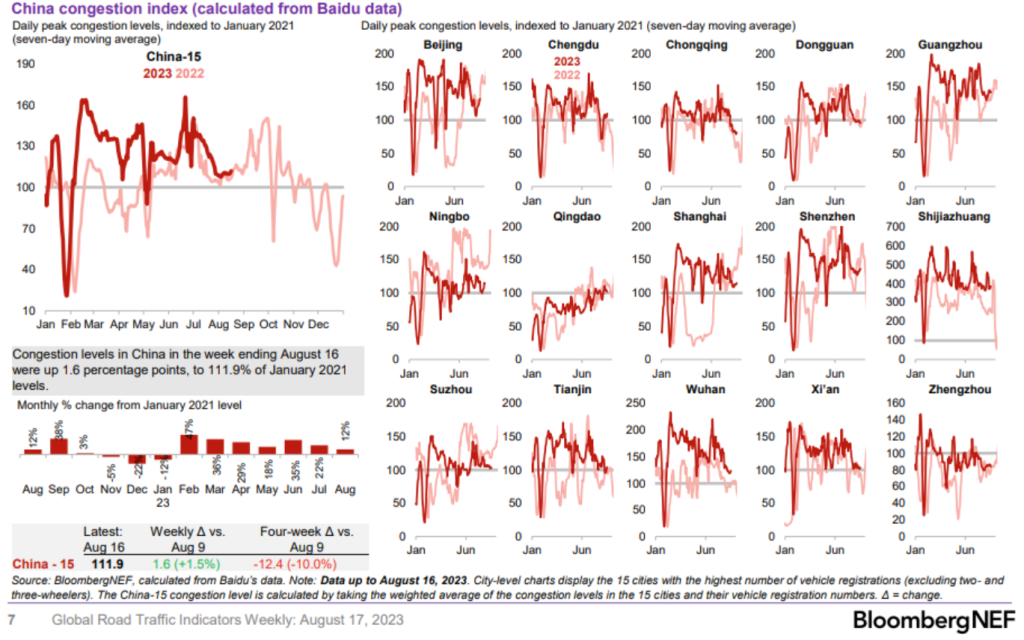
The pressure on crude pricing remains to the downside as we head into September. Saudi has said that would be willing to extend or deepen the cuts, but any of those actions will just keep us in the current range. Energy prices have risen around the world, which has helped push inflation higher around the world. The full acceleration of the price wasn’t felt until August, so we expect to see “flexible” inflation pushing higher again. We are seeing several pivots on inflation metrics that show another bump up across Q3 with more support as we head into Q4. It’s not just the diesel/gasoline price as leading indicators across PMIs, prices paid, and labor costs show how difficult it will be to bring inflation “under control.” “The typical American household spent $709 more in July than they did two years ago to buy the same goods and services, according to Moody’s Analytics.” I think this puts into perspective how much inflation has hit on a month/ month basis. It’s important not to get lost in the y/y numbers because the comps are much harder, but it doesn’t change the fact that price increases have been relentless on a m/m basis. Now- the “hard” base effects are starting to fall away and the comps are getting “easier” which is being aided by the rise of pricing in all facets of life.
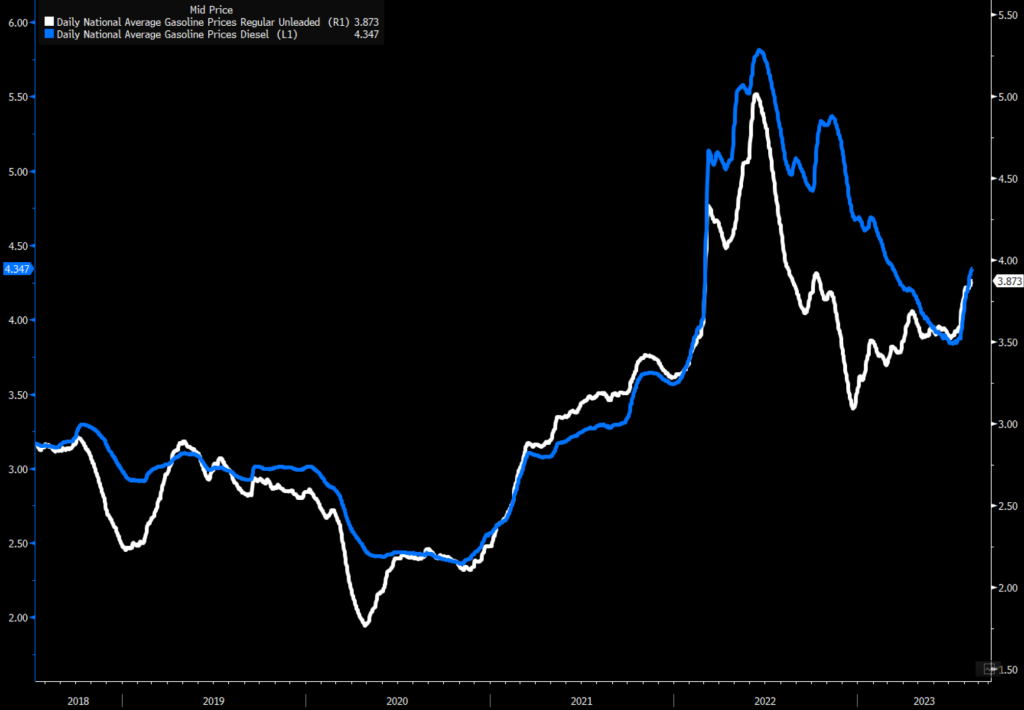
There has also been a BIG acceleration of refined product exports from China and India. Chinese refiners look to be front running the third batch of export quotas. The crack spread has been very strong, which is also helping to incentivize an additional push of product into the market. Chinese economy is also struggling, which is limiting total refined product demand. India’s economy is in a better position, but still slowing as well (just not in the same way or as rapidly) enabling both countries to export more product to capture a healthy margin.
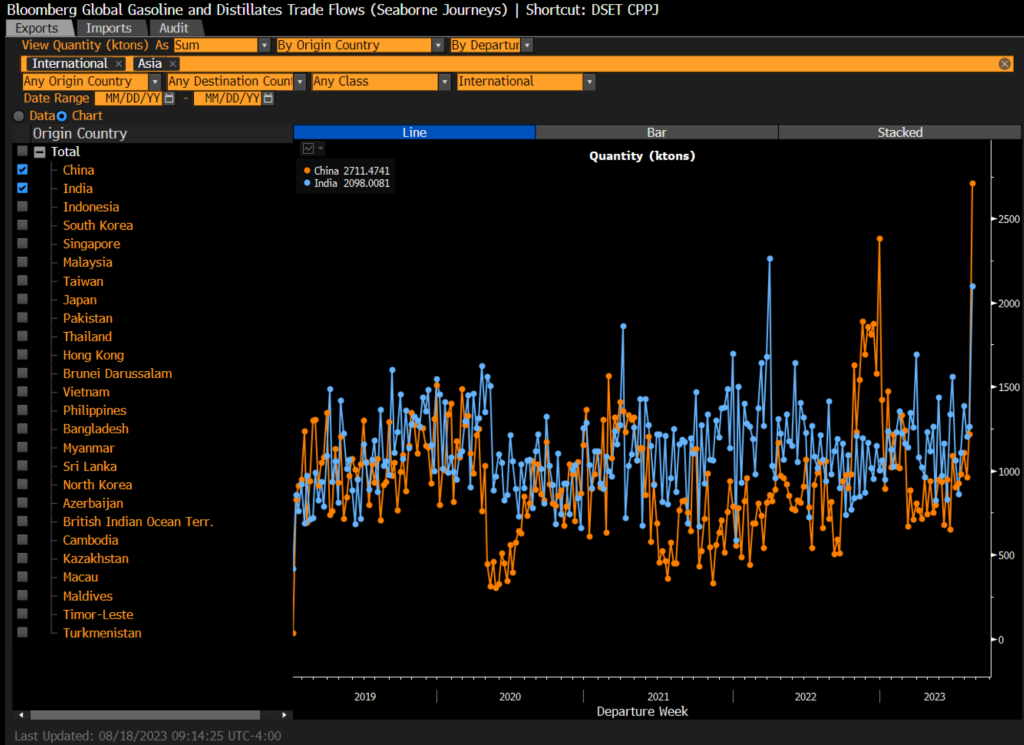
When we look at China, state-owned refiners (SOEs) and Shandong assets have seen a sizeable increase in utilization rates following a huge buildup of crude storage. Teapots (Shandong) refiners have ramped up, but are still running at reduced rates vs historic. On the other hand, SOEs are running hard with another push likely to happen over the next few weeks.

The industry’s largely solid performance contrasted with broader gauges of economic health — including retail sales and fixed-asset investment — that missed expectations, highlighting the challenges facing policymakers. State-owned refiners pushed operating rates to a record 81.19% as of Aug. 3, according to data from OilChem, which expects them to rise further this month. We are expecting a sizeable increase in the export quota that will enable the refiners to tap into the market. This will hit the Asian markets sending some of Singapore storage higher and pushing back into Fujairah. Gasoline and heavy disty/resid will struggle, but the low level of middle distillate storage will help support cracks/storage even as more product gets pushed into the market.

There are already expectations of additional Chinese exports, but I think the market is underestimating flows from India. Right now- East to West arbs are closed keeping volume from moving into the Atlantic Basin. “The market is waiting to see if China will export more volumes but for now, estimates for gasoil exports in August is still 600,000 mt,” said a third regional gasoil trader. This year, China has issued two batches of export quotas for gasoline, gasoil and jet fuel, totaling 27.99 million mt. As of June, 73% of the overall quotas have been used, S&P Global reported earlier.” Exports have already started to spike to close that gap ahead of the new quota.
We have also seen some imports into India/China slow for Russian crude, which has increased the discount for Ural cargoes. This will be an interesting one to watch as China increased volumes of Iranian crude by a wide margin. Iranian crude has been trading at a discount, which has helped it price out Urals/ESPO into China. The below chart helps to put in perspective how much is being imported into China- a record amount.
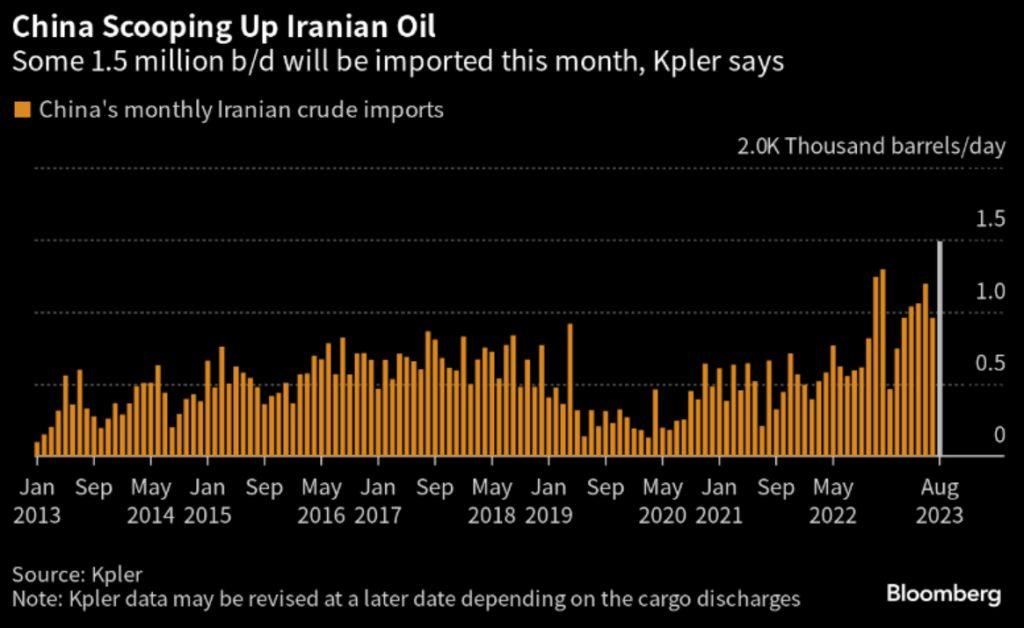
The physical market has “softened” but still remains well above where it was prior to the KSA announcement. We expect to see some steeper cuts in Nigerian crude prices as a significant amount remains ahead of the October schedule.
SPOT MARKET:
- Sales of Nigerian cargoes remain slow, with at least half of 41 cargoes for September yet to find buyers: traders involved in the market
- Demand from European buyers remains muted despite good margins
- European market is still well supplied, partly due to record flows from US Gulf, traders said
- Nigerian loading programs for October expected to be released as early as Aug. 22
- Demand from European buyers remains muted despite good margins
- Most Angolan cargoes for September are cleared; trading cycle for October loading expected to kick off from early next week
Europe is current well supplied from CPC, Libya, and U.S. crudes, which has diminished the demand for Nigerian barrels. We expect to see price cuts of physical Nigerian barrels accelerating in order to clear out space for Sept/Oct. There have already been deferrals in the WAF market, and given their announcement to increase production (export capacity) they can’t afford to have much more slippage.
Some of the new estimates from the main agencies have increased their supply forecasts for next year. The expectation is for supply to grow in 2024, which will push balances to surplus next year. This is why we have said that KSA has backed itself into a corner- they have allowed others to take more market share while they have reduced their production. If they announce an end to the 1M barrel a day voluntary cut, it will cause a sizeable drop (about $5 at the moment) so there is a growing change they will maintain for October and likely rest of the year.
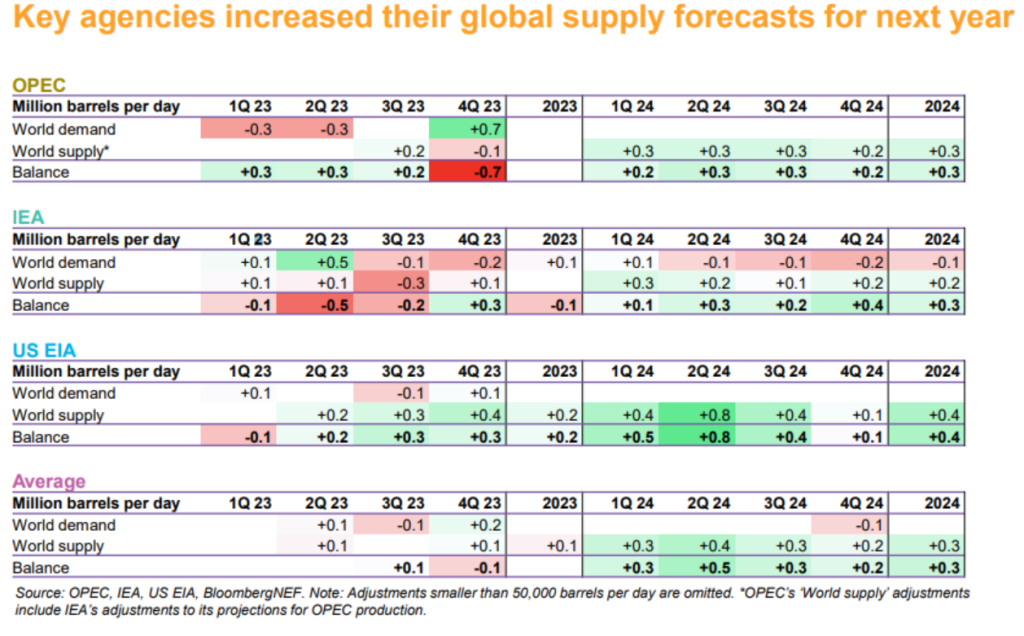
The agencies are all overstating what demand looks like in 2023, because we see more weakness and not strength coming over the remainder of the year. We were “bearish” vs the market for summer demand, and so far the data has come in below our expectations.
The below is another perspective of current balances.
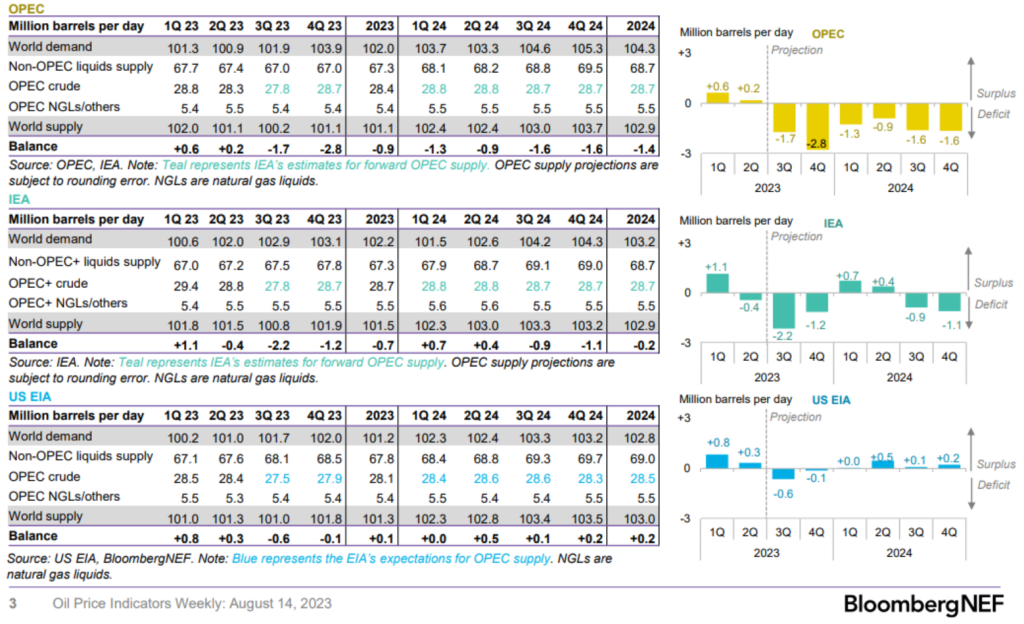
Even with more refined product exports, the middle distillate/gasoil market will remain stronger vs most in the energy space. The lack of heavy/medium crude and low storage levels is helping to offset the slowdown in manufacturing, shipping/trucking, and general industrial activity. The below two charts show the strength in the middle of the stack, which will also draw out more exports to capture this great arb opportunity.
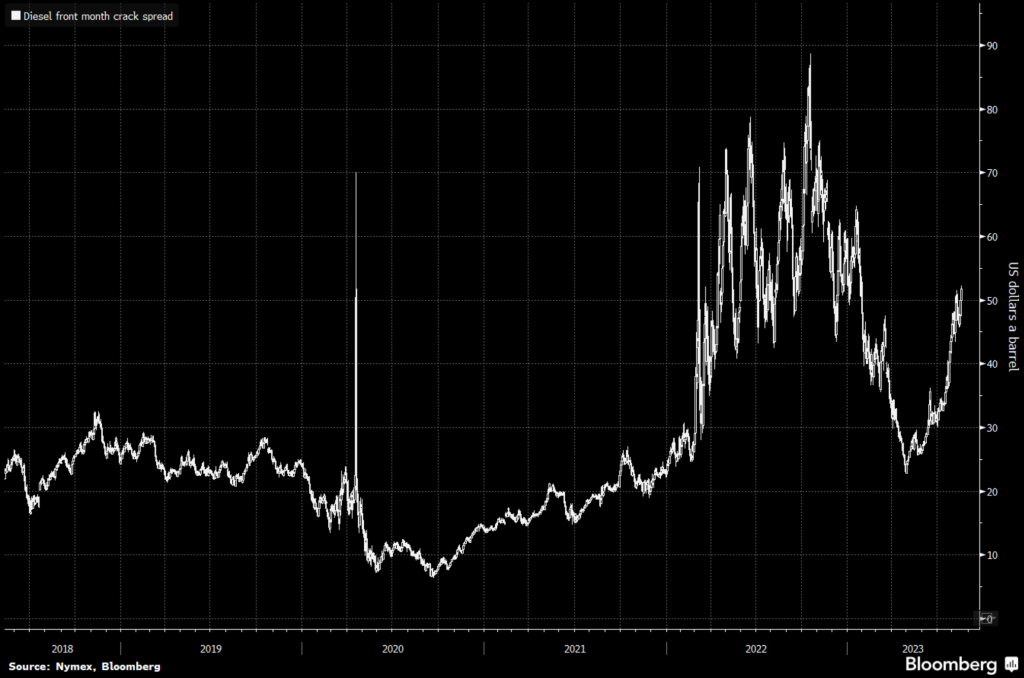
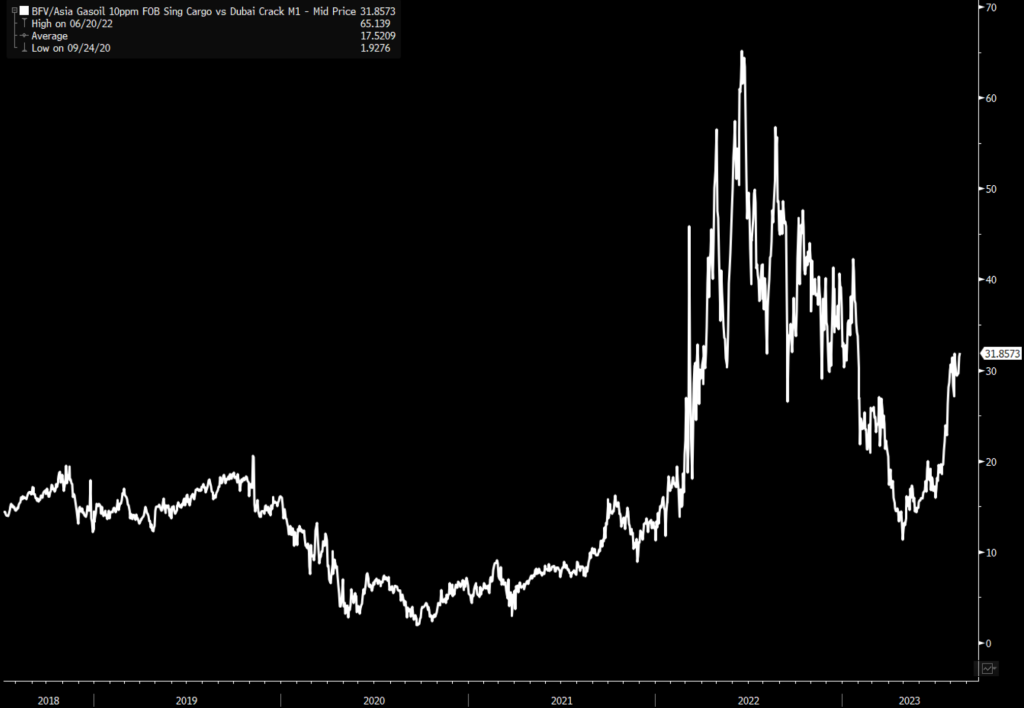
The gasoline situation is in a very different category as we have more increases around the world. We had another surge in Europe, which is struggling to flow to the East Coast (PADD1) because of the tight/closed arb. This is limiting underlying flows, which won’t change until we see a reduction in clean tanker shipping prices.

We see another pivot higher coming in Singapore, but we see middle distillate still remaining very low in all regions as more exports hit the market.
Between energy and food, we are seeing another pickup in inflation that will keep Central Banks with elevated rates. There is likely to be at least one more raise in the U.S. with more to come in other regions as well- especially the ECB. The RBI (Reserve Bank of India) came out more hawkish as there was another spike in inflation that is keeping levels well above their range.
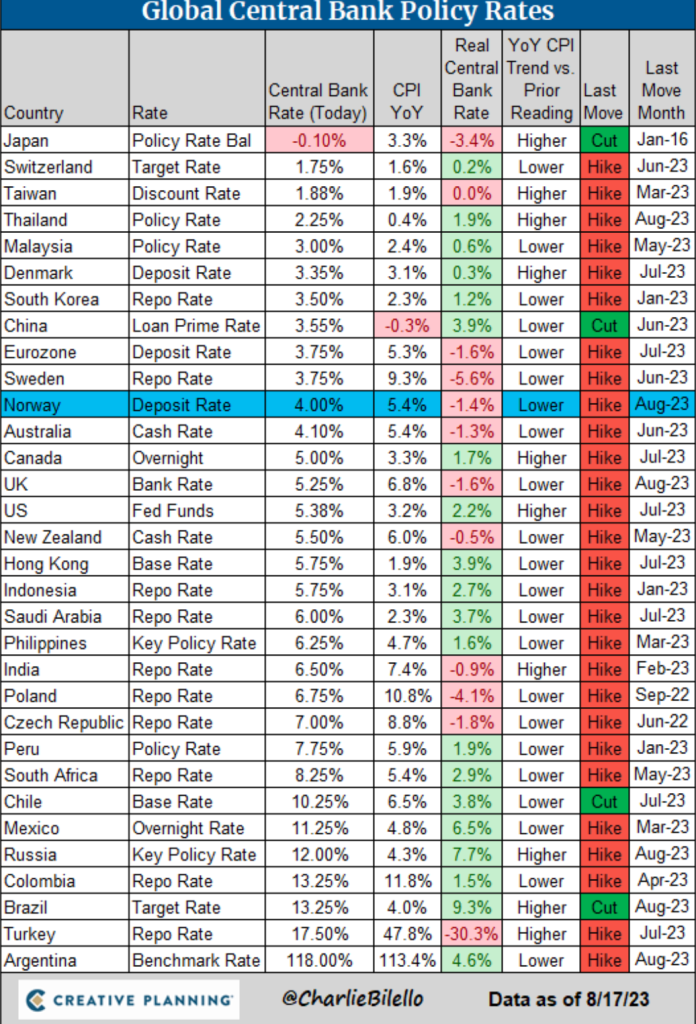
India is very exposed to food inflation when you look at the CPI weighted basket. This was another driver for their restrictions on rice exports as well as wheat.

There was a strong pivot back up, but we also saw an increase across the full weighted basket.


Core CPI weakened a bit but given the initial shock of “flexible”- we see it pivoting higher again keeping the RBI on the sidelines of cutting. We don’t believe this will lead to an increase in rates, but it will keep RBI holding the course. We don’t see much improvement on the food front, which will keep inflation well above the RBI levels.



Globally, trade continues to slow with India also showing cracks that first emerged in Taiwan and South Korea, which has expanded to China and Japan. India will likely be “better” than the others but still weaken over that time frame.
The spike in the U.S. 10 year isn’t going to reverse any time soon, which will reverberate around the world when it comes to all things fixed income. We believe there is more upside to the pressure in the near term, and will likely make a push back to 4.75% once it “meaningfully” breaks 4.25%. It will take some time for it to work through 4.25%, but we believe there will be enough data and pressure to make the break.
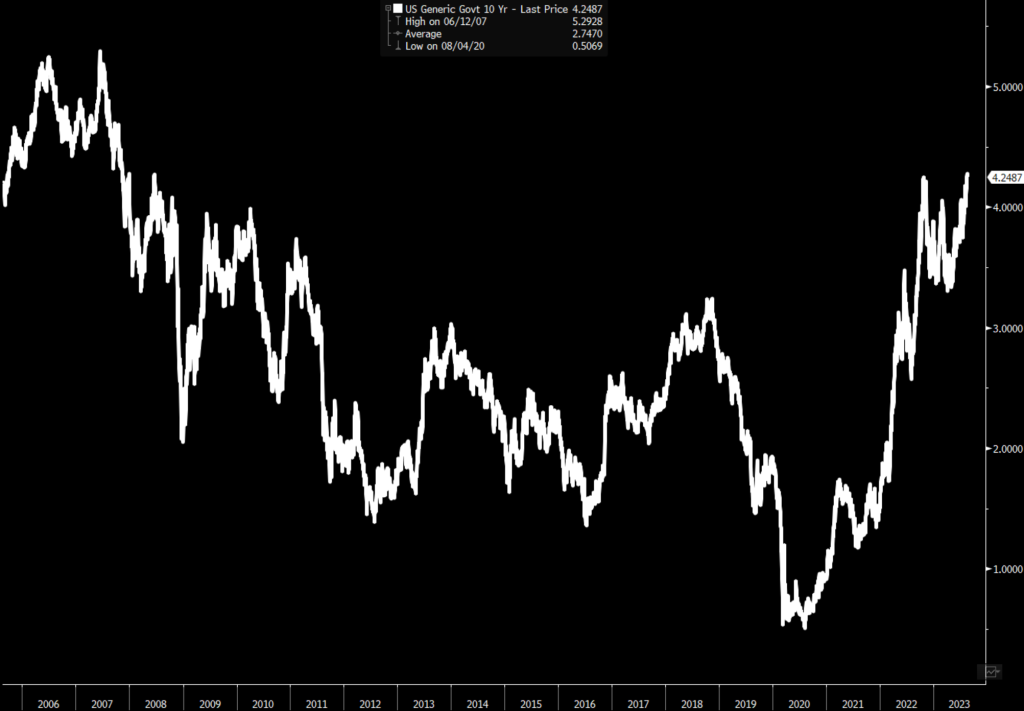
On an adjusted real yield- we are still sitting at about 1.9269%, and this will cross over 2% in the next few weeks. This is why we are confident that credit card rates and mortgage rates are still going to rise. I also think it’s important to put the full impact in perspective when evaluating the amount of fixed income that needs to be refinanced/ rolled. There is a significant amount of debt that will be refinanced at MUCH higher rates vs what it was prior. This will adjust the total principal as well as drive up the interest expense for countries and businesses. The U.S. is no different- “Roughly 75% of outstanding Treasuries will mature within the next 5 years. When new bonds are issued they will likely be at significantly higher yields, driving the interest expense on national debt much higher.”
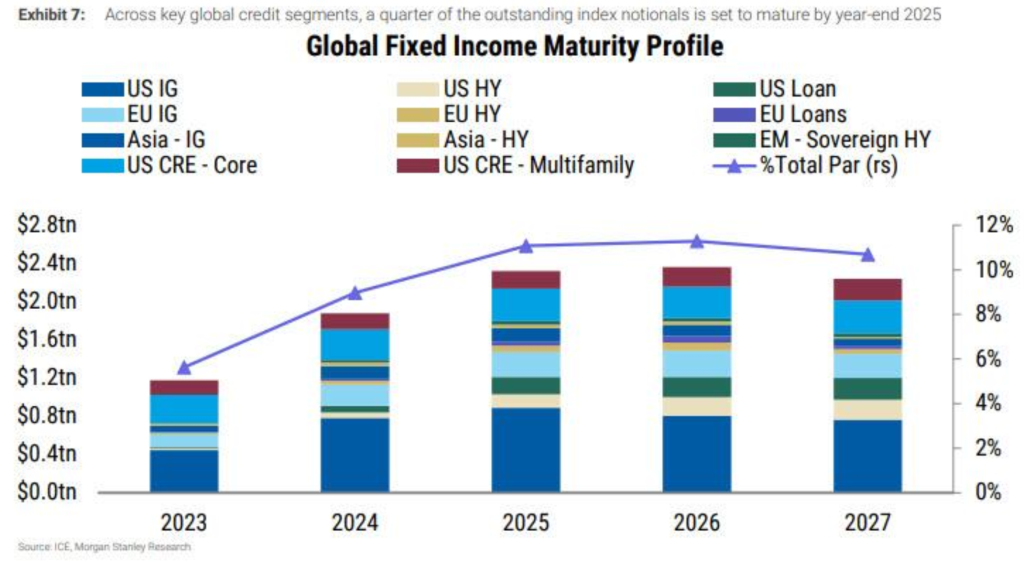
We have been talking about the issues facing the consumer with one of the biggest is the savings bubble being completely exhausted. There is new data coming out that the money has been depleted “faster” than initial expectations- which was our base case. The below chart is the FIRST to show that it’s now officially gone.
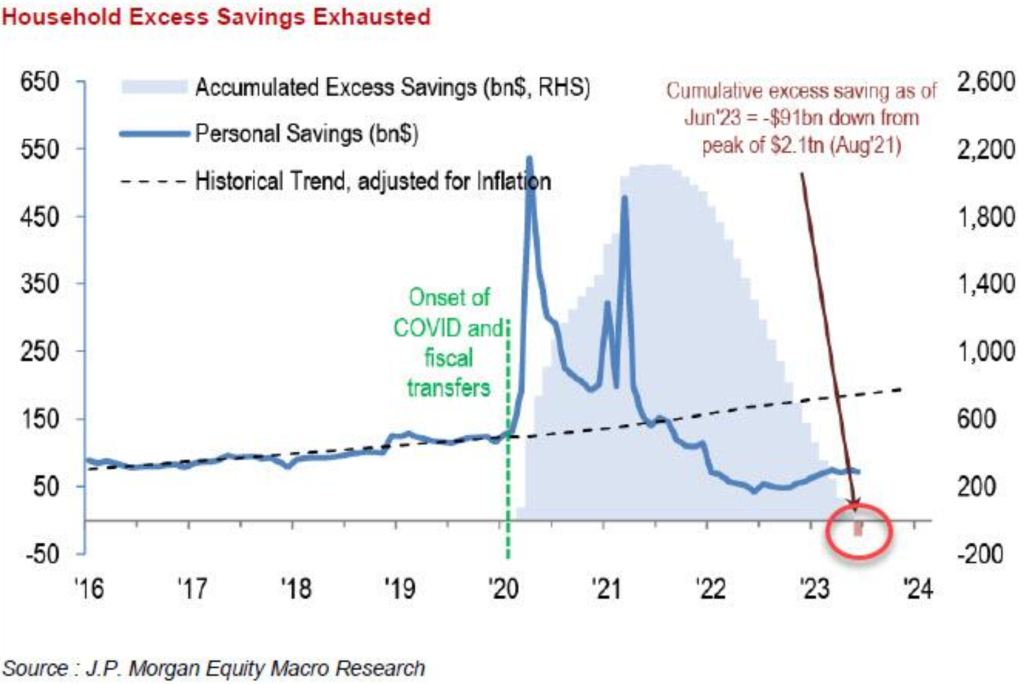
The SF Fed did a deep dive into the data, and showed that the numbers have been drawn down rapidly. They still show some capacity in the savings build-up, but we believe that anything left is sitting at the “highest earning bracket” and will likely stay in the bank.
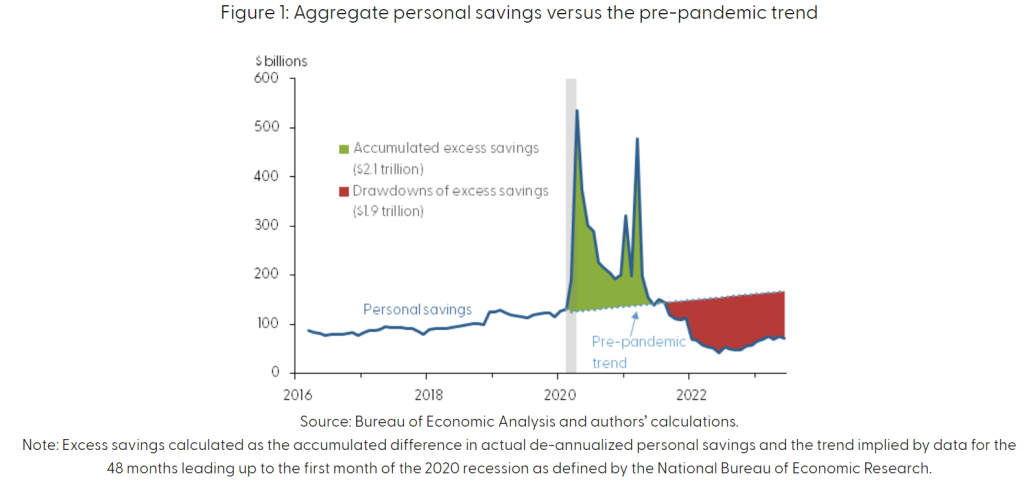
Those that needed it most have seen their cushion fall away last year, which has been the biggest driver of credit expansion. The below chart puts into perspective just how quickly the volumes have dropped, and because of the impacts around the “Law of Diminishing Returns” we aren’t going to get another round.

Inflation is turning back higher and is eroding “real incomes” once again. The consumer was forced to utilize that savings cushion to close the gap when prices accelerated, but as it dwindled- consumers turned to credit and reduced the amount they put into savings.
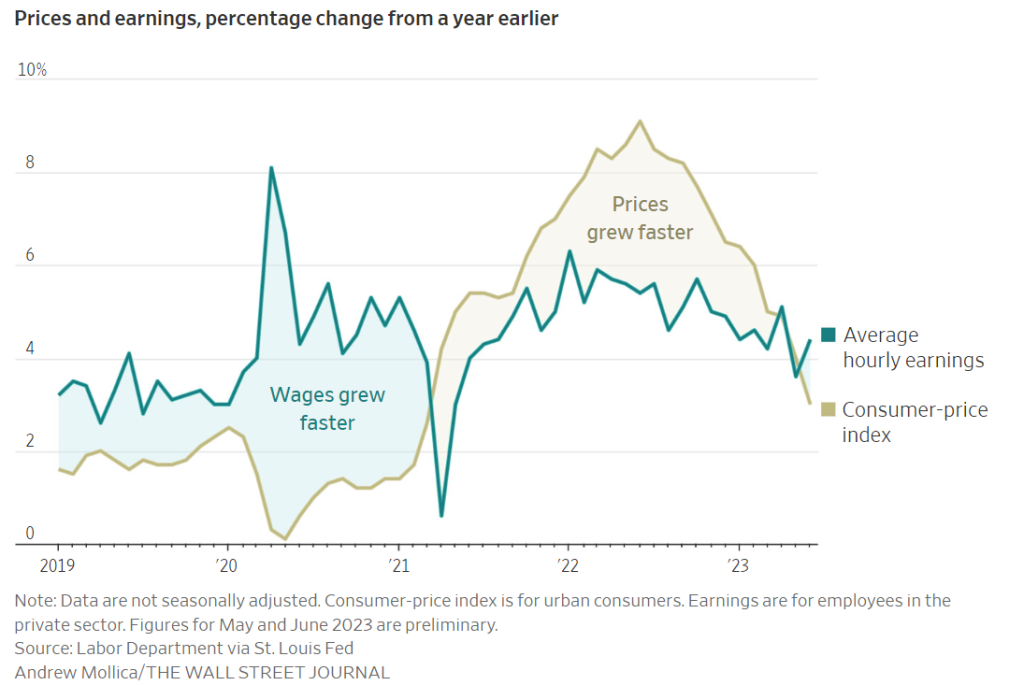
The below data set I think puts into perspective how squeezed people are, and why I think the SF Fed and/or recent JP Morgan data is more realistic to the other data sets.
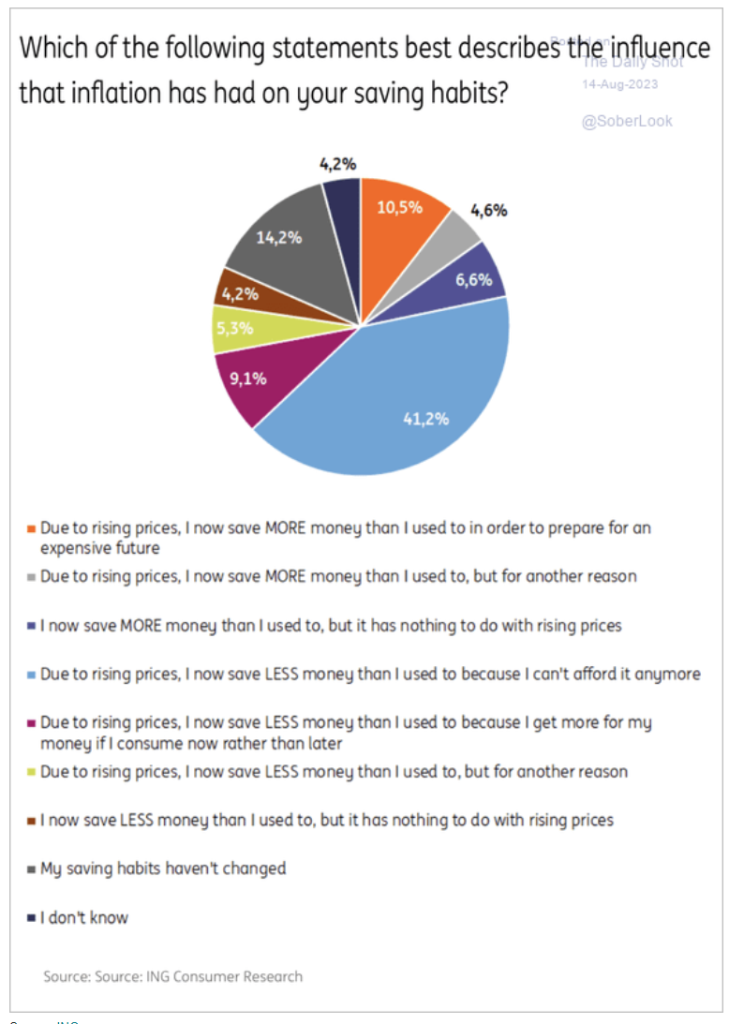
The stress is going to grow in general as rates push higher and more pressure moves to the consumer. The retail sales hung in again this past month driven by nonstore sales, food services, and groceries. We don’t see the food angle changing, instead, it will get worse as the price of food pivots higher once again. There has been a slowdown in eating out, but the trend didn’t really change until we got into August.
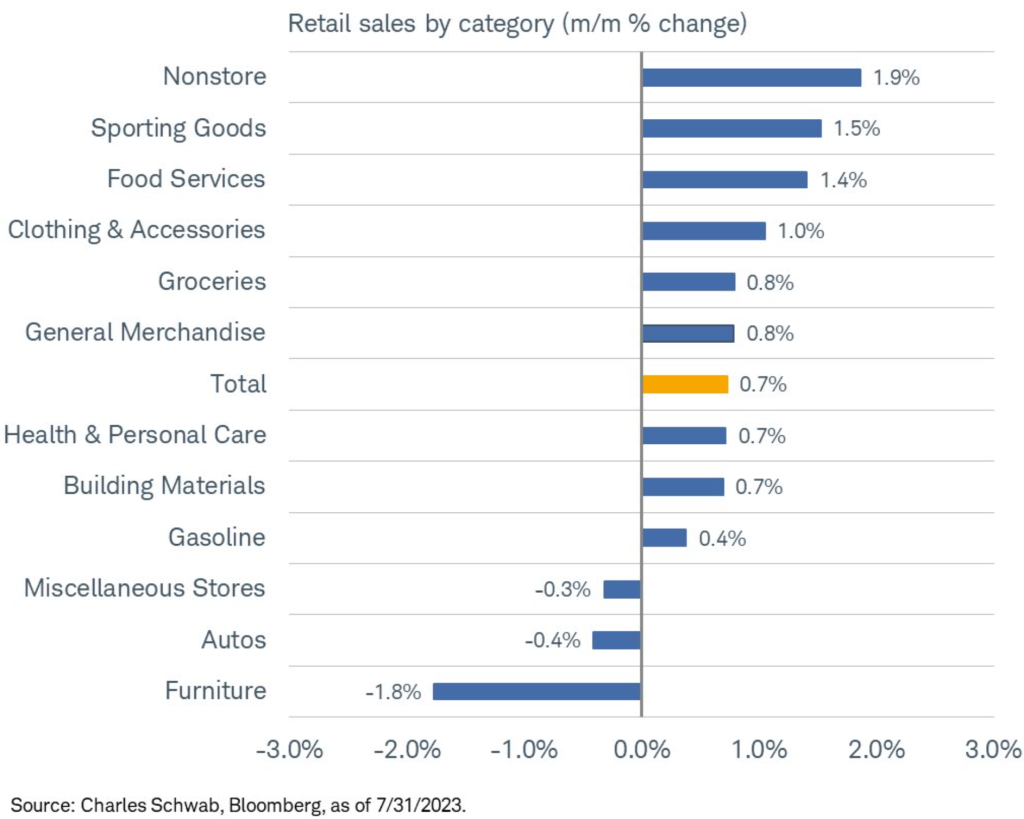
When we adjust for inflation- you can see the data was ok but not great when we look at what is normally a strong period. “After adjusting for inflation, US retail sales fell 1.3% over the last year, the 9th consecutive YoY decline. That’s the longest down streak since 2009. Nominal retail sales increased 2% YoY vs. a historical average of 4.7%.”
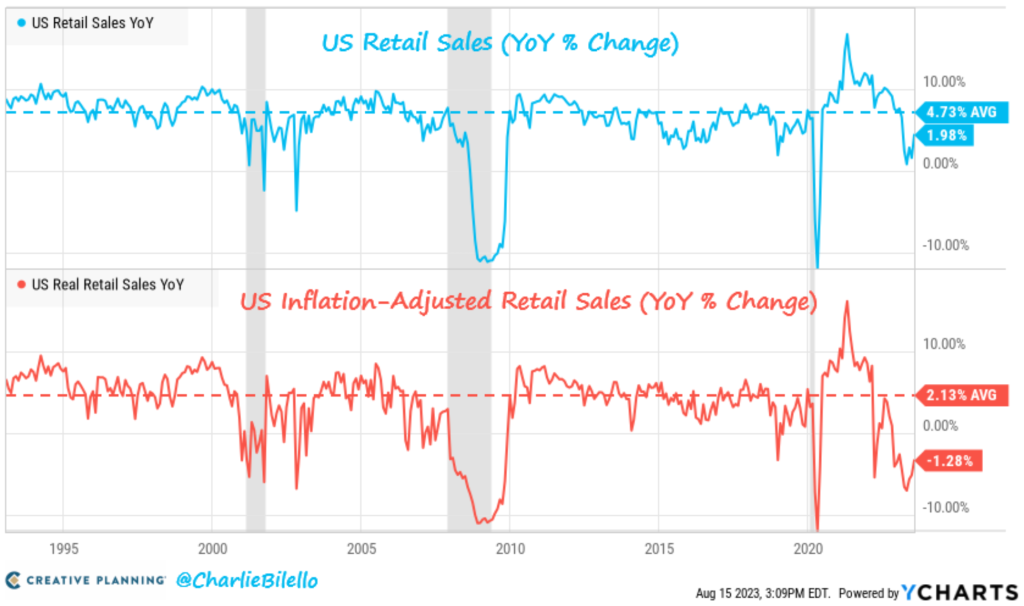
The below puts into perspective the increase in grocery store sales, and how that is going to remain elevated.

The LEI showed more slowdowns in the U.S. and points to a continuous contraction that will get worse over the coming quarter. “Year/year decline in Leading Economic Index (LEI) from @Conferenceboard eased a touch in July to -7.5%, but still a sharp drop from peak and in territory consistent with prior recessions.”
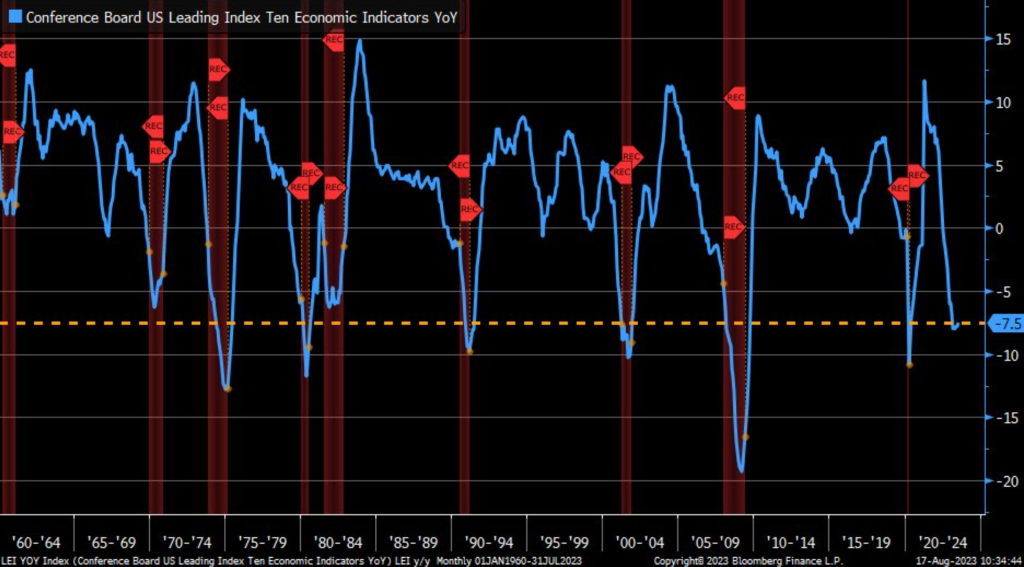
Here are some examples of inflation accelerating: “Inflation pressures coming back? Prices paid component within philadelphiafed. Manufacturing Index jumped in August to highest since June 2022 … monthly swing (orange) was among larger increases on record.”
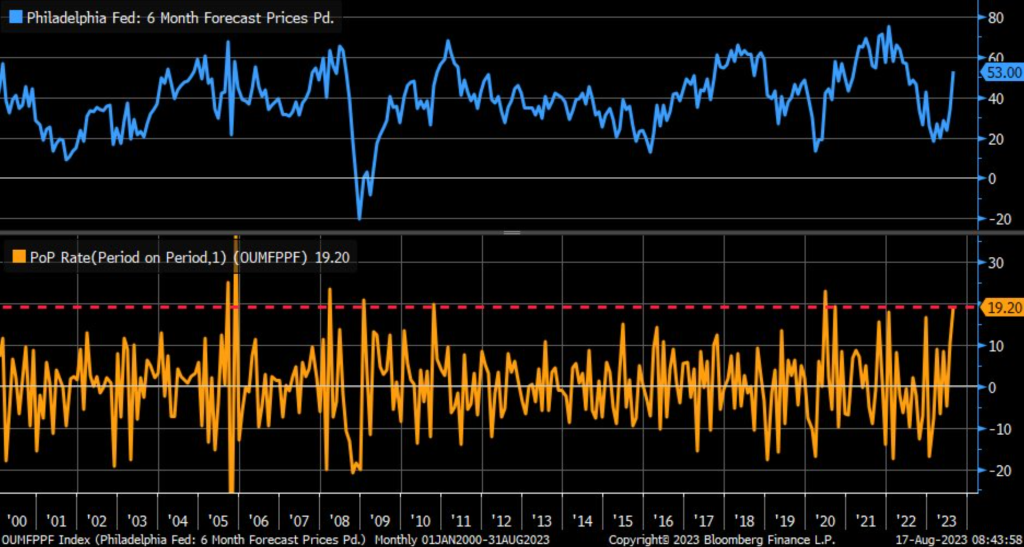
We have seen this bounce in Philly and Empire data, and it matches with all of the data we have been tracking throughout July/August moving higher.
Chinese data weakened further, and we see more pressure coming into this market. I will go through it in more detail, but this gives a good backdrop of where we sit at the moment: https://www.youtube.com/watch?v=hrbu5HLUXwQ
I want to do a big look forward on how China will be over the next few quarters, and I will build it over the next two weeks so everyone has some fun reading for September!













